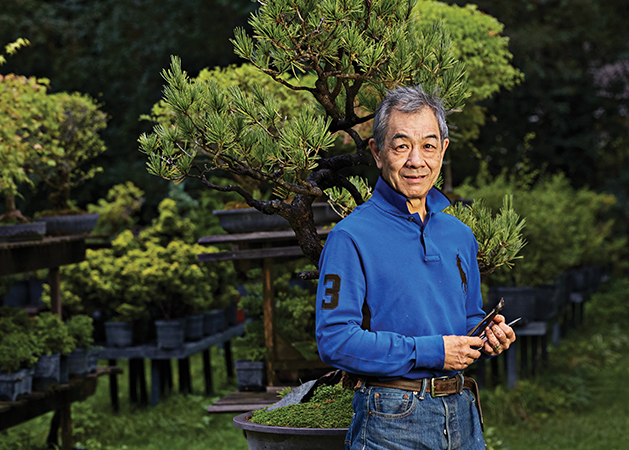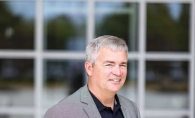
At his home-cum-greenhouse complex in Lakeland, Kevin Oshima does not have a television or a computer. He does have somewhere between 6,000 and 10,000 bonsai plants, along with a household of exotic objects collected over a half century of traveling the world. “Every picture, every rug, every lamp, the piano, down to the toilet seat, is from somewhere else,” he says.
The 68-year old master of the art of living sculpture has traveled the world lecturing at universities and at botanical gardens in places like Bermuda where he helped a client create a memorial bonsai garden. He’s collected tree and plant species from countless locales, such as bromeliads and orchids from the Brazilian rain forest. When traveling to exotic locations like New Zealand, the Amazon rain forest or Papua New Guinea, “I never stayed at universities; I always lived with indigenous people. I learned a lot that way,” he says.
A third generation Japanese American, Oshima grew up in Edina and was the only Asian student at his high schools (Christ the King Academy and De La Salle). He knew little about Japanese culture until fifth grade when he made the first of several summer trips to Japan with his uncle who traveled extensively due to his work with Standard Oil. Oshima also visited Europe, Africa and Brazil. “By the time I was 6 I had been to Europe three times,” he says.
“When I first visited Japan, I was immediately fascinated by the culture. My uncle took me to the village in central Honshu where my grandfather (who had emigrated to America in the early 20th century) still owned property. I was blown away by the people. I wanted to live like a Japanese,” he says. So, Oshima spent that first, three-month visit living in a monastery and learning the culture from Buddhist elders.
He remembers sleeping on mats, being awoken by a large gong at dawn each day, washing up in a frigid creek and then going to a temple to meditate. “It was difficult but enlightening, a great experience,” says Oshima whose family, “comes from a long line of samurai,” those who could protect others, living by values such as loyalty, service and personal excellence. Along with martial arts, samurai have traditionally been expected to also be skilled at “softer” arts such as foreign languages, gardening, music or poetry. “As I grew up, I fell in love with that samurai philosophy. I wanted to live that way,” he explains.
Oshima was inspired to pursue bonsai when he saw his grandfather’s trees and visited the national bonsai collection in Tokyo at the age of 7. He would return to Japan every summer for the next 25 years.


Oshima compares the bonsai world to karate, in which he also happens to hold a first level black belt. During his trips to Japan as a child, adolescent and young adult, “I just tried to find every [bonsai] master I could to study with. The art form was dying after the war, and there weren’t many bonsai schools. So few people wanted to keep [the art] around; [the masters] passed me around. So, I got to study with masters all over Japan and was exposed to many different styles,” he says.
Bonsai styles vary depending on the types of trees used and how they are shaped—upright, formal, cascading, slanted. Some of Oshima’s trees are heirs of the Japanese Imperial collection, hundreds of years old. He grew some from seeds or cuttings. Making these living sculptures requires meticulous root pruning, trimming, wiring, grafting and sometimes adding elements like gravel and moss to create balance and beauty.
The art of bonsai involves not only the preservation of an organism Oshima notes, but prolonging its life and altering its shape. “It’s so much like having a pet plant; you’re responsible for it. [The practice] embodies traditional Japanese values such as simplicity, efficiency and the ability to focus completely on one thing,” he says.
During his formal schooling in Minn., Oshima’s scientific interests were whetted by middle school science expeditions—doing insect studies in St. Paul and small animal studies in the Badlands of North Dakota, for example. After completing graduate horticulture and botany studies at Harvard and the Queens College in England, rather than joining the faculty of some university, Oshima decided to make a living as a freelance lecturer and expedition leader. He put his first expedition together in the early 1970s, a trip to Vietnam doing agent orange studies for the U.S. government. He’s led dozens of expeditions that always included, “the brightest horticulture graduate students. Someone might call and say ‘I love this variety of orchids and they’re only available at this time of year on a mountain in Venezuela.’ I’ll go get it for them,” he says. Several years ago, Oshima was featured on a Discovery Channel program, but he’s never seen it since he lacks a television or any video recording device.
Along with teaching the art of bonsai, Oshima and his employees tend gardens for a number of longtime customers in the Twin Cities. Former Minnetonka resident Beth Ann Segal has worked with Oshima for more than 40 years.
“Every year he housed and cared for my bonsais throughout the winter and returned them to me every spring so that I could enjoy the season with them in my Minnetonka garden,” Segal says. “After my husband died, I sold my home in Minnesota and moved to Tarrytown, N.Y. to be near my family there. Kevin prepared part of my collection and shipped my bonsais to me last spring. Kevin is a master at his craft, a Renaissance man and living his life to the fullest.”
Oshima is the last member of his family to wear the samurai tattoo—two entwined dragons around his neck. Samurai warriors traditionally wore them into battle. “I never went into battle, but I have completed five Pacific Rim marathons,” Oshima says. He’s clearly a man who still loves a challenge.









